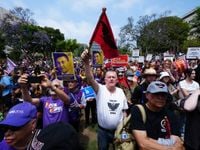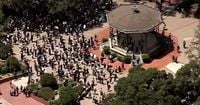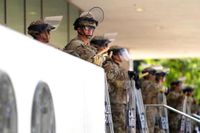Los Angeles has become the epicenter of a fierce clash between federal authorities and state officials following President Donald Trump’s unprecedented deployment of military forces to quell protests sparked by aggressive immigration enforcement raids.
On June 9, 2025, California officials, led by Governor Gavin Newsom, filed a lawsuit seeking to roll back the Trump administration’s deployment of the National Guard in Los Angeles, calling the move both "illegal and immoral." The state argues that the president’s federalization of the California National Guard—without the governor's consent—violates state sovereignty and oversteps constitutional bounds. Attorney General Rob Bonta emphasized the lack of any "migrant invasion" or active rebellion that would justify such a federal takeover, stating the lawsuit aims to obtain a restraining order against what he called the president’s "unlawful action." This legal confrontation marks a rare and significant moment, as it is the first time since 1965 that a president has activated a state’s National Guard against the governor’s wishes. That historical precedent was set by President Lyndon B. Johnson during the civil rights marches in Alabama, underscoring the gravity of the current situation.
By midday on June 9, approximately 1,000 National Guard troops were already deployed in Los Angeles under federal orders, with the total expected to reach 2,000 by day's end. Later that day, President Trump authorized an additional 2,000 National Guard members, effectively doubling the federal troop presence to 4,000. This escalation was accompanied by the Pentagon’s announcement that around 700 active-duty Marines from the 2nd Battalion, 7th Marines—stationed at Twentynine Palms, California—were activated and ordered to deploy to Los Angeles. The Marines are set to support the National Guard and federal law enforcement personnel, though Pentagon officials declined to specify their exact mission or deployment duration. Notably, the Insurrection Act of 1807, which would allow the president to use military forces for domestic law enforcement without usual legal constraints, has not been invoked.
Governor Newsom condemned the deployments, calling the mobilization of the Marines "completely unwarranted, uncalled for, and unprecedented—mobilising the best in class branch of the US military against its own citizens." He also warned that such federal actions could set a dangerous precedent, potentially leading to similar deployments in other states. Newsom publicly demanded the rescinding of the federal orders and denounced the president’s actions as "reckless" and "disrespectful to our troops." In a fiery exchange on social media platform X, Trump and his border czar, Tom Homan, taunted Newsom, with Trump even suggesting that the governor should be arrested for impeding immigration enforcement. Newsom responded, "The President of the United States just called for the arrest of a sitting Governor. This is a day I hoped I would never see in America." Los Angeles Mayor Karen Bass also voiced deep concerns, describing the city as "being used for an experiment" in expanded federal authority and warning that further immigration raids could spark "pandemonium." She stressed that local protesters were ready to respond swiftly to any new enforcement actions.
The protests themselves have been intense and at times violent. Demonstrations began after federal Immigration and Customs Enforcement (ICE) raids on June 6 in Los Angeles and nearby Paramount, which resulted in the detention of over 100 immigrants over the course of the week. The arrest of David Huerta, the California president of the Service Employees International Union (SEIU), during these raids further galvanized union members and activists. Huerta was charged with conspiracy to impede an officer during immigration enforcement and was later released on a $50,000 bond. Large crowds gathered near Los Angeles City Hall on June 9 to demand his release and protest ICE’s actions, chanting "Free Huerta now!" and holding signs declaring "Immigrants make America Great" and "We want justice." Similar protests took place in other cities, including inside Trump Tower in Manhattan, with more than a dozen demonstrations planned nationwide.
Over the weekend of June 7-8, some protests escalated into clashes with police. Los Angeles streets bore the scars of unrest—broken glass, graffiti, looted shops, and charred remains of cars set ablaze during confrontations. Law enforcement used tear gas, flash bangs, and more than 600 rubber bullets and other less-lethal munitions to disperse crowds after projectiles were thrown. Police arrested 29 people on June 7 for failure to disperse and 21 more on June 8 on charges ranging from attempted murder with a Molotov cocktail to assault on officers and looting. Five officers sustained minor injuries. Journalists covering the protests were not spared; an Australian television reporter was struck in the leg by a nonlethal round while reporting live, and a British photographer remained hospitalized after surgery for a similar injury sustained during protests in Paramount.
Community leaders have voiced the human toll of the raids and military deployments. Indigenous activist Perla Rios spoke outside Ambiance Apparel, one of the ICE raid sites, urging legal representation and due process for detained immigrants. "What our families are experiencing is simply a nightmare," she said, highlighting the fear and uncertainty gripping many immigrant households. Protesters and advocates decried what they view as a campaign of terror and injustice against vulnerable communities.
Despite the heavy military presence, reports from the ground on June 9 indicated that the National Guard largely played a passive role, primarily guarding federal buildings rather than engaging directly with protesters. Al Jazeera correspondent Rob Reynolds noted that the protests organized by unions in downtown Los Angeles were peaceful that day. This raised questions about the necessity of deploying active-duty Marines, a combat-ready force typically stationed overseas, to a domestic protest environment. Newsom’s office clarified that the Marines were being repositioned to a base closer to Los Angeles rather than deployed on city streets, though the symbolism of such a move underscored the administration’s hardline stance.
The political and social ramifications of these developments are profound. California’s lawsuit challenges the constitutional basis of the federal deployments, emphasizing the importance of state sovereignty and the limits of presidential power. The protests reflect widespread opposition to the Trump administration’s immigration policies and tactics, which critics accuse of sowing fear and division. Meanwhile, the federal government maintains that the deployments are necessary to protect personnel and property and enforce immigration laws, with border czar Tom Homan insisting the Marines’ presence is needed to quell unrest.
As Los Angeles braces for continued protests, with a fourth consecutive day of demonstrations underway on June 9, the city remains a focal point of national debate over immigration, federal authority, and civil liberties. Schools have announced safety perimeters around graduation sites, and local leaders urge calm amid the tensions. The unfolding events reveal a nation grappling with deep divisions and the limits of governmental power in times of domestic unrest.
In this fraught moment, the stakes could not be higher—not only for the residents of Los Angeles but for the broader American experiment in governance and the rule of law. The deployment of military forces against the will of a state’s elected leaders revives memories of a turbulent past and raises urgent questions about the balance between security and freedom.



